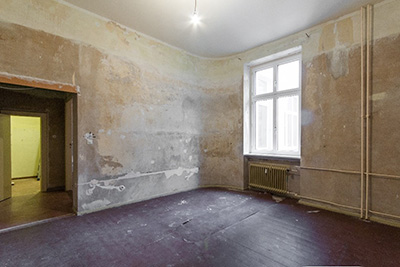Asbestos in Drywall: A Complete Guide
Up until just a few decades ago, homes throughout the U.S. were built with a variety of asbestos-containing products, from roofing products to floor tiles. The use of asbestos in drywall was especially common.
Asbestos drywall was very durable and resistant to heat and fire—but it also contained deadly fibers. Today asbestos exposure has been linked to diseases like mesothelioma, and asbestos is no longer used in the manufacture of drywall. But homeowners and those who work with drywall should still be aware of potential dangers.
Does Drywall Have Asbestos?
Most drywall installed between the 1920s and 1980s had asbestos in it. Asbestos drywall became popular in the 1920s because it was an easier, more affordable alternative to plaster. Asbestos was added because it was plentiful, cheap and increased the drywall’s heat resistance and durability. In the 1950s, the housing boom increased demand even more.
By 1980, asbestos products had been linked to diseases such as mesothelioma, lung cancer and asbestosis. Manufacturers stopped using asbestos in most products, including in drywall and related materials. However, any asbestos products already in stock remained on the shelves, so homes built into the 1980s could contain asbestos in drywall.
Asbestos in Joint Compound
Other materials used with drywall, like tape and joint compound, also contained asbestos. In the drywalling process, the installer first hangs the sheeting, or the large boards of drywall. They next use tape over the seams between boards, then cover it all with joint compound to smooth it out. They also use joint compound around fixtures and to fill in holes, which means it could be found throughout your walls, not just at the board seams. Because it’s so widely used and can be easily disturbed, joint compound with asbestos is also a health hazard.
What Does Asbestos Drywall Look Like?

Asbestos in drywall, joint compound and tape is difficult to identify, as it looks similar to products without asbestos. If you know the manufacturer, you can look up whether they used asbestos in their products. The manufacturer or date may also be stamped on the drywall. This wasn’t a common practice before asbestos was identified as a health hazard, but you may be able to rule out asbestos this way. If your drywall is stamped with the year 1990 or after, it probably doesn’t contain asbestos.
If the drywall was installed before the mid-1980s, it’s safest to assume that it contains asbestos. The only way to be sure is to test it. You can buy an at-home testing kit or have a professional take a sample. Either way, be sure to test all layers and materials, including the drywall sheeting, joint compound and tape.
Health Risks and Safety Measures
Asbestos in drywall is only dangerous if it becomes airborne. When materials containing asbestos are disrupted or damaged they release dust into the air that contains small fibers. When inhaled, these fibers can damage the lungs over time and cause asbestos-related diseases, including mesothelioma. Once installed and sealed with paint, asbestos drywall isn’t a health hazard. But for homeowners doing renovations and for high-risk professions, like drywall installers, maintenance workers and electricians, it can be.
Homeowners need to take special precautions when working with asbestos drywall. You’ll need a class P1 or P2 respirator, eye protection, a full work suit and gloves. You’ll need to learn procedures like how to wet down the drywall to reduce dust and how to dispose of the waste correctly. While it’s tempting for homeowners to “DIY” an asbestos project, it’s a job that’s best left up to the professionals.
Regulating Asbestos in Drywall
There is currently no complete ban on asbestos in the U.S. In 1972, the Consumer Product Safety Act did ban asbestos in wall-patching compounds, which helped to reduce its usage in the construction industry. The EPA also banned spray-on asbestos applications, which were used in popcorn ceilings, in 1973. Yet other asbestos materials continued to be used to build homes.
While both U.S. Congress and the EPA found it difficult to ban asbestos outright due to challenges in the courts, they were able to create and enforce strict regulations around its use, handling and disposal. In addition, consumers became more aware of the dangers and began filing lawsuits against asbestos companies. Together, regulation, consumer awareness and litigation put an end to the use of asbestos in drywall and other building materials.
Regulations for Homeowners and Landlords
There are plenty of homes and buildings throughout the U.S. that were built before the 1980s and used asbestos in drywall. Requirements for homeowners who want to sell or renovate these homes, as well as landlords who want to rent them out, vary by state.
Some states require that homeowners who are aware of asbestos let potential buyers know about it. Your ability to renovate may also be regulated. For example, some areas don’t allow you to remove any amount of asbestos without professional help, while others only let you remove small amounts. Even if you’re legally allowed, most areas regulate the disposal of asbestos waste, including using special bags and providing a notification to your local environmental agency.
In general, landlords must provide “habitable” living conditions. However, they’re typically not required to remove asbestos or notify tenants about its presence, as long as they keep the property in good condition. Requirements for tenant notification, and for renovating and removing asbestos, vary by state.
What to Do If Your Drywall Contains Asbestos
Asbestos in drywall can be a serious health hazard if the fibers are released into the air. Asbestos has been linked to mesothelioma, lung cancer and other respiratory diseases. If you’re planning to work with drywall that was installed before the mid-1980s, the best thing to do is test it for asbestos. If it’s positive, have a contractor that specializes in asbestos abatement remove and dispose of the drywall.
If you’ve been diagnosed with mesothelioma and worked with asbestos drywall in the past, you may have a right to compensation for medical bills, lost wages and other expenses. An attorney specializing in these cases, like the lawyers of Early, Lucarelli, Sweeney and Meisenkothen, can help you determine what caused your mesothelioma and get the compensation you deserve. Contact one of our attorneys for a free case evaluation today.
FAQs
What is asbestos and why is it found in drywall?
Asbestos is a naturally occurring mineral that was used in many products during the 20th century. When added to various materials, it made them fire- and heat-resistant and more durable, making it an especially popular addition in construction materials like drywall.
How common is asbestos in drywall?
Asbestos is very common in drywall that was installed before the mid-1980s. It became popular in the 1920s as an alternative to plaster and was used in nearly all drywall until its dangers became well-known in the 1980s.
What are the health risks associated with asbestos in drywall?
When asbestos drywall is disturbed, for example by sanding or drilling, it releases small fibers that can get lodged in the lungs. These fibers are linked with numerous diseases including mesothelioma and lung, ovarian and laryngeal cancer, as well as respiratory problems like asbestosis.
How can I identify asbestos in drywall?
Asbestos drywall, tape and joint compound look the same as products without asbestos. It’s safest to assume that if these materials were installed before the mid-1980s, they contain asbestos. You should have these materials tested before disturbing them.
How dangerous is exposure to asbestos in drywall?
Exposure to asbestos in drywall can result in disease. Occupations that worked with drywall before 1980, like installers or other construction workers, or that currently work with older drywall, like renovators and electricians, are most at risk for developing asbestos-related diseases.
Can asbestos in drywall cause mesothelioma?
Yes—asbestos in any material can cause mesothelioma if the fibers are released into the air. The longer you’re exposed to it, and the higher the concentration of the fibers, the more likely it is to cause mesothelioma. However, no amount of asbestos is safe to inhale.
Request a Free Case Evaluation
Request a free case evaluation now if you or someone you love has been diagnosed with mesothelioma. The evaluation will cost you nothing. Our lawyers will travel to visit you at your convenience or conference call with you over the phone. We understand how difficult a time this is for you and will assist in any way that we can. You can also call us toll-free at 1-800-336-0086 at any time.

Results
The jury awards and settlements we have received for our clients are among the highest in the country.
Occupation/Exposure
Mechanic
Age
66
State
WA
Results
~$102,200,000
Occupation/Exposure
Cosmetic Talc User
Age
75
State
AZ
Results
~$22,200,000
Occupation/Exposure
Talc Powder User
Age
59
State
UT
Results
~$20,000,000
Occupation/Exposure
Home Renovator
Age
75
State
RI
Results
~$15,100,000
Occupation/Exposure
Electrician
Age
62
State
NV
Results
~$13,800,000
Occupation/Exposure
Plumber
Age
49
State
CA
Results
~$13,500,000
Occupation/Exposure
Abatement Worker
Age
70
State
CT
Results
~$12,600,000
Occupation/Exposure
Pipefitter
Age
58
State
OH
Results
~$12,200,000
Occupation/Exposure
Pipefitter
Age
65
State
NV
Results
~$12,000,000
Occupation/Exposure
Navy Veteran
Age
48
State
CA
Results
~$11,700,000
Occupation/Exposure
Air Force Veteran
Age
84
State
KY
Results
~$11,700,000
Occupation/Exposure
Hairdresser
Age
66
State
MD
Results
~$11,500,000
